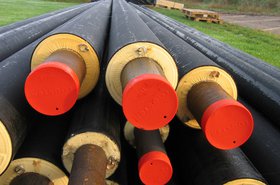Data centers are the engine of our innovation economy - they power the cloud infrastructure we rely on every day and will be central to our computing needs for many years to come as they provide critical support for the cloud and emerging technologies including generative AI.
Those technologies also require huge amounts of energy - much of it employed to cool the servers, processors, and other equipment. According to recent research, about 40 percent of a data center’s total energy use is for cooling. Excess heat is released into the atmosphere through cooling towers or evaporative condensers, literally throwing heat away. In a 300,000 square foot data center with 12,000 racks, annual cooling costs could be between $5 and $10 million per year, depending on location and technologies.
However, as the Department of Energy notes, there are both energy and cost savings opportunities with data centers. The path to achieving that goal can both help the planet and contribute to organizations’ efforts to reach net-zero goals, as well as enhance profitability, by converting the cost of rejected “surplus heat” into a useful by-product as an “input” to a district energy system.
A district energy system typically uses a central plant to recover, produce, and deliver heating and cooling through an underground piping network to an aggregation of customer buildings to form an “energy district.” The district can be a city’s downtown business area, a college or university campus, a corporate research cluster, a military base, or an airport. Some energy districts may include well over 200 buildings.
With a district energy system, a large percentage of the surplus heat can be recovered via heat exchangers and transferred as useful thermal energy for serving customers. Essentially, this process is akin to finding puzzle pieces where the two sides fit together perfectly – data centers generate heat they don’t need or want, and district energy system operators need significant volumes of heat for space heating, domestic hot water and process loads for connected customer buildings.
While data center waste heat recovery is widely employed across northern Europe, particularly in countries like Finland, Sweden and Denmark, in the United States, use of the technology is not yet as common. However, if you’ll pardon the pun, it is starting to pick up steam. A large reason for these regional differences is in the nature of the steam itself.
Throughout much of the world, including in Scandinavia, district thermal systems are hot water-based. However, in the United States, a majority of existing heating systems distribute steam to customers.
In other words, the recovered heat from a data center is often easily integrated into a hot water system, although as low-grade heat it may require additional heat input to “top-up” the heated water with a heat pump or boiler to reach adequate supply temperatures for the district network requirements.
Data center heat can also serve as first-stage heat for district steam systems, pre-heating boiler make-up water before it is fully converted to steam. Other considerations for data center heat recovery include proximity and interconnection costs, water quality and maintenance and metering and billing functions.
While there are hurdles to deployment, data center heat recovery in the United States and Canada is gaining traction. It can be advantageous to incorporate waste heat recovery at the beginning of the planning and development phase of new systems or expansion projects. California has mandated waste heat recovery for data centers as part of its 2022 Building Energy Efficiency Standards, known as Title 24.
Innovation in this space is emerging from the private sector. Major corporations are employing these strategies in the US, including Amazon - one of the world’s largest operators of data centers and one of the pioneers of cloud computing. In 2017, Amazon developed a heat recovery system at its corporate headquarters in Seattle, as part of the company’s wider strategy to meet its net-zero goals.
The Amazon building in downtown Seattle houses a central plant that services a district system, and is located across the street from a data center. The Amazon data center provides up to 5 MW of excess heat to supply Amazon’s district energy system meeting the annual space heating and process hot water needs for about four million square feet of space.
Using heat recovered from data centers in a district energy system provides a reliable, cost-effective source of energy that can benefit both the data center operator and nearby building owners.
While district energy systems have been part of the energy landscape for over 140 years, the connection to renewable sources like waste heat recovery, demonstrates how district energy systems can also play a pivotal role in the energy transition to a decarbonized, net-zero future.





